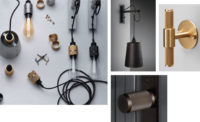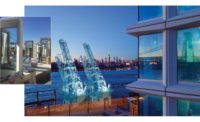Big Sur, California
Driving to Big Sur on coast-hugging Highway 1— say, south from San Francisco—you have to be cautious. It's not just that the switchbacks give the ride the feeling of being in a James Bond movie, but that it is impossible not to be subsumed by the scene outside the windshield: the verticality of the lush and hoary mountains and the plunging cliffs that spike up again from below the surface of the Pacific Ocean.
It was Fougeron’s success in conceptualizing and gently positioning an earlier, rectilinear house in a wooded valley in Big Sur—the Jackson Family Retreat—that endeared her to the clients of her recent nearby project. A Chicago-based executive and his family had been looking for property in the area since the late 1990s—he fell in love with Big Sur when he attended prep school in Monterey in the 1970s—and in 2006 they finally purchased a triangular 1.5-acre site on a bluff with a 250-foot drop to the ocean. “We wouldn’t have closed without [Fougeron] onboard,” he says. The couple knew that they didn’t want a dark stone and redwood cabin like the ones so prevalent in the area, but something daylight-filled, with a low profile, and made of a mix of materials.
Fougeron conceived a copper-clad and glass volumetric form set into and hugging the cliff. As it subtly zigzags down the slope with its slanting roofline, it resembles, according to the architect, the curve of the Pacific banana slug, her inspiration. “The clients loved the weird shape. That was the big move,” she says. “But it had to feel as if it really was a house. It is modern in its conception but warm in its materiality.” The structure is invisible from the road (the sacrosanct view from Highway 1 is protected), but its drama—a cantilever on two sides that thrusts the nose of the house out over the bluff—is only slowly revealed as you descend the site on foot.
The highest volume, entered from the driveway, contains an open-plan living room and kitchen, wrapped in warm mahogany on the south-facing walls and set off by limestone floors. To the north, the facade is almost all glass—large panels set in a robust but elegant custom steel-framing system. This allowed the architect to create vast glazed openings to border the ocean and coastline, as well as have them withstand 70-to-80-mile-an-hour winds. To provide visual relief from the relentless theater of the view, Fougeron opened the living room to a quiet sunken terrace to the south, protected by the natural berm and retaining wall behind it.
A nearly all-glass library unites the living room and kitchen on the upper part of the slope with the master suite on the lower, and alerts visitors of their journey into the more private wing. The placement of roof glazing required workers to wear rappelling gear and was one of many moments when the challenging site scared the project’s construction manager, Thomas George, according to Fougeron. “He thought I was crazy to do this,” but “we didn’t want structural columns everywhere.” Five perforated steel beams in the glass roof connect to a beam that sits on the bearing wall. They also disappear enough to help create the effect of a planetarium, a perfect spot to observe the sparkling view outside, day or night. But it’s the master bedroom that is the grand denouement. “They wanted this to be a sanctum at the end of the house,” says Fougeron. With floor-to-ceiling windows (no doors, to limit temptation and accidents), it seems to hover in the sky over the ocean, with a 12-foot cantilever to the west and north.
The simplicity of the house’s form belies the feats of engineering that were required to anchor it to the precarious site, ensure it could withstand earthquakes and erosion, and protect the environment around it (see sidebar). A below-ground concrete bunker is perpendicular to the grade-level volumes and contains bedrooms, storage, and mechanical systems while serving as an enormous anchor.
In addition to the northern glass facade, a connection to the outdoors is maintained from east to west, all the way from the living room through to the master bedroom, because of interior fenestration near the ceiling. Initially, Fougeron was concerned about the views’ overwhelming the intimacy of the interiors, and proposed alternating clear and frosted glass panes. “Then, one day, we were at the construction site,” explains the client, “and after both of us stared at the beautiful ocean view for about 10 minutes, she said, ‘You know, maybe “overwhelming” isn’t such a bad thing.’ ”
CLOSE-UP: FIRM ANCHOR
Says Paul Endres, an engineer who has worked with Fougeron for 20 years: “It was one of the most complex projects we’ve done.” The Fall House is set 12 feet back from the edge of a bluff—an “erosion line” that should keep the structure safe for at least 100 years, if not more. The bedroom wing cantilevers from that line, with all of the structural support occurring behind it. Other gymnastics ensure that the house isn’t going anywhere: it has a concrete pier-and-grade beam foundation with pilings 10 to 30 feet deep, the deepest of which are placed at the precipice of the cantilever. A series of double moment frames with c-shaped flanges intersect at certain points, and are also sloped at angles. “Usually moment frames go in a single direction and can’t run into each other,” says Endres. In order to get the complicated configuration to work, “We drilled holes and rammed rods through moment frames. I haven’t seen that used professionally before,” he says.

|
| Photo © Joe Fletcher |
| Rather than disturb the smooth plane of the roof’s horizontal surface, the architect placed circular vents in the fascia (not shown). |
Completion Date: May, 2013
Size: 3,800 square feet
Total construction cost: withheld
Architect:
Fougeron Architecture
140 Geary Street 8th Floor
San Francisco, CA 94108
T 415.641.5744
F 415.282.6434
People
Architect:
Personnel in architect's firm who should receive special credit: Interior designer: Fougeron Architecture
Engineer(s):
Consultant(s):
General contractor:
Photographer(s):
CAD system, project management, or other software used: |
Products
Structural system Manufacturer of any structural components unique to this project: Coastal Fabrication
Exterior cladding Metal/glass curtain wall: custom steel sections and glazing
Roofing
Windows
Glazing Skylights: Insulated Solarban
Doors Wood doors: Custom clad Sliding doors: Quantum
Hardware Pulls: Doug Mockett & Co., Inc.
Interior finishes Suspension grid: Stain mahogany Demountable partitions: Cabinetwork and custom woodwork: custom white and wood stained Wall coverings: Stain mahogany tongue and groove Paneling: Stain mahogany tongue and groove Solid surfacing: Corian in bathrooms Floor and wall tile: French limestone Carpet: custom wool carpet at master bedroom
Furnishings Chairs: B&B Italia Tables: B&B Italia
Lighting Task lighting: Track lighting by Halo Exterior: Sistemlux, B-K Lighting Dimming System or other lighting controls: Lutron |
















